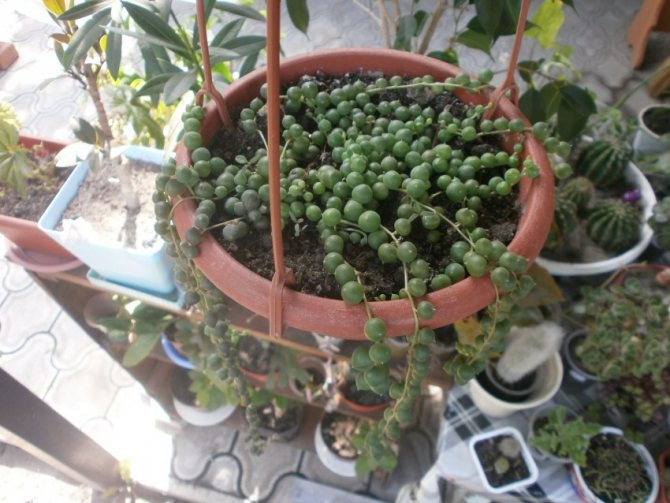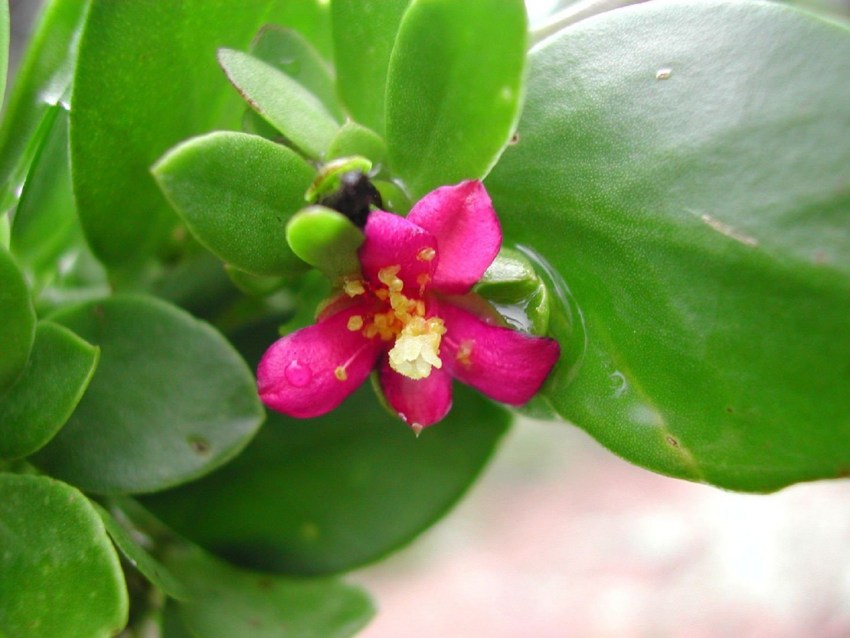Varieties
Today, there are various types of this plant:
- pereski Godseff;
- prickly (shark);
- orange;
- pereskia Grandiflora (bolshetsvetkovaya);
- Pereski Weber;
- peresky sucrose;
Pereskia Godseff
This variety can reach a length of two meters. She has an erect, thin stem. It has elongated black spines. Small white flowers. The leaf blades are narrow, their length can reach 6 centimeters. They are elliptical in shape.

Spiny (shark)
It is a liana-like leafy cactus. Its stems are woody. The shoots of such a flower are creeping, they can cling to with thorns. The spines of the prickly variety are straight, the length can reach 2-3 centimeters. Leaves are dense and fleshy, their length is about 7-10 centimeters. The upper part of the leaf plates is green, the lower part is red. The flowers are either pink or white. They have a pungent lemon scent. The fruits are yellow berries, no more than 2 centimeters in diameter.

Orange
This type of pereski can grow up to 8 meters in length. The stems are covered with olive bark, their diameter can be 10-15 centimeters. The leaf blades are large and have distinct veins. Leaves grow on long petioles. The flowers grow bright orange in color, no more than 4-6 centimeters in diameter. The fruits of this species are cone-shaped, have a pineapple aroma, but they cannot be used as food. It is believed that it is this variety that can be used for the manufacture of medicines. After all, it is able to reduce pressure, blood sugar levels.

Pereskia Grandiflora (large-flowered)
Its length can be up to 5 meters. The stems of such a plant are covered with thorns. The stem itself is chestnut in color, has a rough surface. The leaf blades are elongated, 20-23 centimeters long. They crumble at a temperature of +10. The buds of such a flower are large. Their color is deep pink. As a rule, they grow in inflorescences of 10-20 pieces, but flowers can also grow one at a time.

Pereskia Weber
It is a shrub 1 to 3 meters long. Their root system is thickened. The leaf blades are small in size, they are attached to the flower without cuttings.
The flowers are small, pink in color. Their diameter is about 2 centimeters.

Pereskium sucrose
It can be up to 7 meters long. Shoots grow in an unusual curved shape. The leaves are long, reaching 10 centimeters. On such a plant, you can find thorns 2-4 centimeters. The buds of this variety are larger than other species, their diameter is more than 6 centimeters. Their color is pink.


Types of prickly pears
Opuntia species are diverse, there are more than 300 of them. Many varieties are grown at home.
Opuntia fig
The fig prickly pear has its own peculiarity. The appearance of the plant is practically no different from others. The leaves are round, different sizes, green. After flowering, in the middle of autumn, fruits are formed at the ends. Outwardly, they resemble figs, which is where the name comes from. After ripening, a juicy red pulp forms inside. What is it fig prickly pear? In countries where it grows in large numbers, it is a delicacy. Various dishes are prepared from it. Also, these berries are famous for their nutritional value and beneficial properties.
Indian prickly pear, or fig, blooms from early spring to autumn. Bright orange flowers with elongated pointed petals are forming. There are fine light hairs in the center.

Cactus fruit
Prickly pear
In its natural environment, it grows in the valleys of Mexico at an altitude of 1000 m above sea level. The sizes of the cactus are quite large. It all depends on the growing conditions. The more free area, the larger the plant. The leaves are flat, fleshy, large, dark green in color. Small dots with a large number of small needles are located on them. It is rather difficult to consider them. The bundles are white. Flowering occurs in a natural environment, it is difficult to achieve it at home. The flowers of the prickly pear, or Microdasis, are large, beige, with stamens in the center.
Important! Small needles should not be touched with hands without protection. They quickly penetrate the skin and cause discomfort
Cylindrical prickly pear
The cylindropuntia cactus grows in the tropics and subtropics. The plant reaches a height of 2 m. Separate processes of the cylindrical prickly pear have an elongated shape. Covered with small green glochidia. These are kind of green leaves. The maximum length is 5 cm. Sometimes long sharp single spines form instead of them. At home, flowering is very rare. In their natural environment, large red flowers bloom.
Garden prickly pear
Garden prickly pear, or frost-resistant prickly pear, has several varieties. This cactus is famous for the fact that it can be grown outdoors, without shelter. It takes root well in the middle lane, as it is winter-hardy. Flowering pleases the entire summer season. Depending on the variety, it blooms with yellow or red flowers.

Potted cactus
Other
The most popular varieties of cactus are described above. In addition to them, there are other varieties:
- Opuntia Subulata. The succulent plant has an oblong stem. On the surface there are yellow needle-shaped spines, white tubercles. Flowering occurs once a year, lasts from spring to autumn. Forms bright red flowers.
- Berger's prickly pear. The plant reaches up to 1 m in height. The leaves are round, fleshy, dark green in color. They have yellow needles. It blooms with bright orange flowers with dense stamens inside.
- Opuntia Monacanth. The plant has an unusual shape. Green leaves with brown needles extend from the stem. Each sheet has a unique shape. It does not bloom in indoor conditions.
- Opuntia is variegated. Medium-sized cactus. The leaves are green, rounded, with small outgrowths. From them branches off with red flowers. Long needles are located on the surface of the leaves.
- Brazilian prickly pear. It is large in size, grows up to 1 m. There is a central stem, from which leaves, round, green. The surface is covered with needles, a small white bloom is visible on the stem.
The variety of species has no boundaries. There are succulents that look like an ordinary cactus. Many of them are thornless, without needles, others, on the contrary, are thorny, covered with needles of different sizes.
Conditions for growing zygocactus
A photo of a plant can tell a lot to an experienced florist. So, if you keep him in the wrong conditions, then after a while the Decembrist will start to get sick, his shoots may dry out or the roots may rot. And it will be difficult to hide it even from the camera. And if all his needs are satisfied, then he will delight with flowering and healthy appearance.
Basic growing conditions:
- Lighting. Zygocactus prefers bright, but diffused sunlight. But the shadow can adversely affect the development of the plant. If a person chooses on which windowsill to put the Decembrist, then he should give preference to the eastern and northern windows. If this is not possible, the plant must be shaded in the summer at noon.
- Temperature conditions. This tropical plant prefers to be warm all year round. In the spring and summer, in the room where the Decembrist is grown, the temperature should not be lower than + 18 degrees, and in the winter - + 16.In August, when the buds of future flowers are laid, it should not be colder than + 11 degrees. During the rest period, the thermal regime should remain within + 6-8 degrees.
- Air humidity. For normal development, it is necessary to constantly moisturize all varieties of zygocactus. A photo of a well-hydrated plant can be seen below. Spray with warm, settled water from a spray bottle.
- Soil and container for planting. Decembrist is grown in loose and light soil with a pH level of 5-6 units. The composition of the soil: 1 part of sod land, 2 - sand and peat, 4 - humus, 6 - leafy soil. The planting container should be wide and medium in size.

By creating conditions close to natural, it is possible to ensure that the zygocactus will develop well and bloom profusely every year.
Home care
At home, the ancient cactus grows quite quickly. It does not need special care. There are several rules for keeping a deciduous cactus.
Lighting
It is a light-loving plant, but the scorching sun should be avoided. In the summer months, there is a window on which Pereskia stands, shaded with a grid.
The best place for this cactus is south windows, especially in winter.
Due to the lack of lighting, the stem is stretched out, and the leaves become small and dull.
Recently purchased flowers cannot be immediately placed on the windowsill, exposing them to the sun. You need to get accustomed to the sun's rays gradually.
Temperature
In the summer months, the temperature should be no more than 27 degrees. In winter, during the dormant period, it is 10-15 degrees. The room must be ventilated, the cactus loves fresh air.
Air humidity
Air humidity does not affect the development of the ancient cactus in any way. Even during the heating season, when the air in the apartment is especially dry, the flower feels good. Spraying the leaves should be done solely to remove dust. And for the prevention of pests.
Watering
Watering should be carried out no earlier than the soil in the pot dries up. You need to water it with soft water, which has been kept for at least a day. The plant requires abundant watering during the period of intensive growth.
Fertilizer
In winter, you do not need to fertilize the flower. And in the remaining months for fertilization, you need to use special fertilizer mixtures for cacti. The dosage is used half as much as described in the instructions. Fertilizers are applied monthly at the root. It is undesirable to use organic fertilizers.
Transfer
It is not recommended to transplant adult plants more often than once every 2-3 years.
Youngsters are transferred as they grow up.
Adults cross over when the root system fills the entire pot.
For transplanting, you can use ready-made soil, or you can prepare it yourself.
Take 2 parts of leafy, turfy land and humus, add 1 part of sand. For transplanting, you need to take large pots. Put drainage on the bottom of the pot, then use the prepared earthen mixture. After transplanting a cactus into a new pot, increased growth begins.
Reproduction
Ancient cactus propagates using seeds or ripe cuttings. You can use water for rooting. Place the stalk in a glass of water and replace it periodically.
Alternatively, you can use an earthen mixture, as for replanting, but with a little charcoal. The ground must be constantly moist. The most suitable temperature is 26 degrees.
Care
In order for the pereskia to grow healthy, you need to periodically carry out procedures to care for it. So, it is necessary to carry out periodic watering, fertilize and fertilize.
Watering
Pereskia can grow and develop normally even with low humidity levels in the pot. But at the same time, in order for the plant to be healthy and beautiful, it should be sprayed with clean, settled water. In summer and spring, watering is carried out when the upper part of the soil dries up in a container with a flower.

Top dressing
Pereskia is especially in need of fertilization in the spring.To do this, you should use special feeding for cacti, which are sold in specialized stores. It is recommended to introduce them once every 15 days under the root. It is also worth diluting the product twice as much as written in the instructions. Fertilizers are not used in autumn and summer. It should be remembered that such a flower does not like nitrogen-containing substances, therefore, it is generally better not to introduce organic matter into the soil. Otherwise, rot may form in the root system. Pereskia needs fertilization during the growing season and flowering. Moreover, the introduction of dressings is carried out along with watering. Typically, use only half of the fertilizer at a time.


Diseases and pests
If a cobweb appears on the underside of the leaf, and small dots can be seen on top, then a spider mite has appeared. The leaves will begin to lose their color, become pale yellow.
Dots on the surface are formed from the suction of juice by mites. Gradually, these dots grow in size, forming large whitish spots, which can lead to shedding of leaves.
The spider mite infects the plant in dry air. Therefore, in preventive measures, it is worth periodically humidifying the air. You also need to remove fallen leaves, periodically wash the leaves from dust.
First of all, if a spider mite is affected, the plant should be treated with soapy water, after covering the soil. If the lesion is extensive, then chemicals should be used.
Another pest is the cactus scale insect.
It can be orange or pale yellow in color with a rounded shield, about 2 mm.
They mainly affect the upper side of the leaf.
After damage, yellow spots appear on the leaves.
After a while, the leaves fall off.
First of all, you need to treat the leaves and the trunk of the plant with a soft cloth or cotton wool dipped in soapy water. You can use a soap-alcohol mixture: mix 30 g of liquid soap, 20 ml of alcohol in 2 liters of warm water. In case of severe damage, chemical preparations must be used.
The most dangerous pest is the mealybug. It is about 4 mm in size. The largest congestion can be observed on young shoots. The mealybug produces a sticky liquid that can contaminate the plant. A spider web appears on the leaves, new shoots and leaves are deformed, flowers fall off.
It is necessary to treat the plant with soap or soap-alcohol solution. Then you need to spray three times, with an interval of 1 week, with garlic broth or calendula tincture.
Also, improper care can be the cause of the disease. When the soil is waterlogged, the root system decays. The only way out is to transplant the plant into a new land.
Attention! Before planting in a new pot, you need to treat the roots with charcoal.
When the soil dries up, the plant weakens, the leaves become lethargic and fall off over time.
The Pereskia cactus is used not only for decorative purposes. It is used by experienced growers to inoculate other types of cacti.
Having bought such an unusual cactus, it is worth remembering that it comes from antiquity. And with proper care, it will certainly become your pride among indoor flowers.
Types of transfer
In total, about 20 species are known, in indoor floriculture there are only a few:
Pereskia large-flowered - can grow up to 5 m, the trunk is thick with thorns, the leaves are shiny leathery, can fall off in winter at low temperatures. The flowers are pink.
Pereskia orange - grows tall in natural conditions, the leaves are large, with a pattern of veins. Outwardly, the flowers are similar to a rose, bright red-orange. The shape of the fruit resembles a pineapple, has a yellow color, and is inedible.
Pereskia prickly - liana with green leaves and fragrant white flowers. Young plants have curved thorns, old ones - straight ones.
Pereskia Godzef - young plants have erect stems that hang down over time, narrow elliptical leaves, greenish-golden on one side and red-violet or red on the other. The flowers are shaped like a wild rose, white.
Pereskia Weber - bushes up to 3 m tall, with a thick rhizome. It blooms from spring to the end of summer white, propagated by seeds and cuttings.




















































